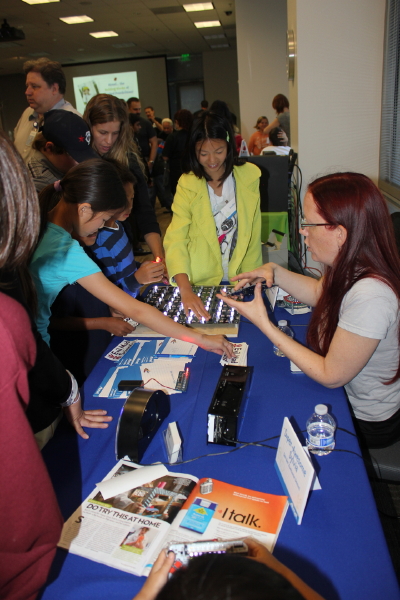Eric Weddington of Atmel shows off a wafer full of ATmega328P chips (as found in Arduino and many of our own kits) at Maker Faire New York.
That’s about 1500 chips on an eight inch wafer, and not something you see every day!





This week is Maker Week in New York, and on Friday, September 20, Windell will be moderating the Atmel Analyst Panel: The Maker Community and Education. Panelists will include Massimo Banzi of Arduino, Quinn of QTechKnow, Reza Kazerounian, Bob Martin and Sylvie Barak of Atmel, Brian Jepson of Make Books and AnnMarie Thomas of the University of St. Thomas. The event will be at the Hilton Manhattan East at 11:00 am, and walk-ins are welcome. You can contact pr@atmel.com for more information about attending.
Super Awesome Sylvia and I were invited to attend Bring Your Kids to Work Day at Atmel recently. (Atmel, of course, is the company that makes the microcontrollers found inside Arduino products and in many of our own projects and kits.) We were there to help provide tangible, interesting, and playful examples of how Atmel chips can be used. And of course, we weren’t going to miss an opportunity to visit Atmel headquarters!

The biggest hit with the kids were the Octolively interactive LED modules (sporting the Atmel ATmega164P). When the kids waved their hands over them, the LEDs would light up and ripple. Some of the kids would start out by poking and grabbing at the LEDs until they lit up, but as soon as I told them it would work “even without touching it” their eyes would get big, and they’d wave their hands over the top, enthralled.
Some of the other things we brought were our handheld game, the Meggy Jr RGB (with the ATmega328P); a Bulbdial Clock (Atmega328P again), which points rings of LEDs at different heights down at a central point to create shadow hands of different lengths; our giant Alpha Clock Five (ATMega644A); and the Larson Scanner (ATtiny2313A), which lights up nine red LEDs to make a scanning robot eye.

Another project that captured the kids’ attention was a Keepon by BeatBots. Other demonstrations included a quadcopter and a hacked hexabot.

We got to have lunch in the bright sun in the courtyard with Avary Kent, who was demonstrating the PuzzleBox, a brain-controlled helicopter.

Sylvia got to give the PuzzleBox a try, triggering it to fly as soon as she concentrated hard enough.
After lunch, we got to tour of a couple of labs. This workbench was well stocked with a Metcal soldering iron (our favorite) and lots of tools and supplies.
Apparently the poor Pleo on this bench needed some repair.
This machine is for inspecting and testing chips after they have been removed from their housing.
We got to go into the RF anechoic chamber, and watch as our cell phones stopped receiving any signals.
We also had some time to hang out and horse around with friends new and old. Our friend Paul Rako seemed to be having as much fun as the kids.

Thanks to Paul and Atmel for inviting us to visit!
Our friend Paul Rako posted a nice write-up about us on both the Atmel blog and EDN Workbench blog, filled with pictures he took at our last open house.

Evil Mad Science does not re-sell cheap imported junk. They design, test, and package their kits right here in Silicon Valley. Here are just a few of the kits Evil Mad Science sells. They all have great style, panache and entertainment value.
You can see read the rest of his post and check out his pictures either at EDN or Atmel. Thanks, Paul!
This will be interesting to a small subset of our readers, but we’re finally seeing ATmega328P chips in the wild. This is a new chip from Atmel that is nearly identical to– but with twice the memory of– the popular ATmega168 microcontroller, the microcontroller in the Arduino and in our (Arduino-compatible) Peggy 2.0. They are still in short supply, but they’ll be a lot of fun to play with. :)
In the photo is one of these on one of our “business card” AVR target boards that we designed for the ATmega48, ’88, ‘168, and ‘328, so it’s finally lived up to its name.
For a recent project, I needed to control sixteen or seventeen LEDs with a microprocessor. The one that I chose was the Atmel ATtiny2313, because it has 20 pins, with up to eighteen outputs, can run without an external oscillator, and is fairly inexpensive at around $2.00 per piece.
Since I’ve got a Mac laptop and no real serial or parallel port, I opted to go with a USB-based programming solution. Furthermore, I wanted to program in C, not assembler, and use open source development tools. Since I was (eventually) successful in all of these goals, I thought that I should write up a few notes about it.
Continue reading Programming the Atmel ATtiny2313 in Mac OS X